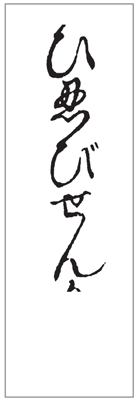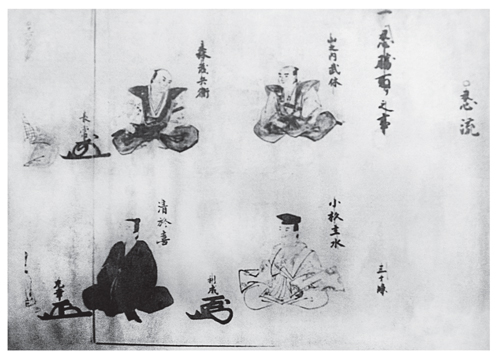Read In Search of the Niinja Online
Authors: Antony Cummins
In Search of the Niinja (11 page)

This image leaps off the page for a shinobi researcher as it is the classic shinobi however, in this case, it is a secret love or love affair.
however, in this case, it is a secret love or love affair.
The following section will expand on the preceding examples and display the various instances when the word ‘
nin
’ is in direct relation to the shinobi. Furthermore it will show the diverse ways in which the ninja were integrated into the military society of Japan, making them not an alternative culture to the samurai, as somtimes thought, but an integral part of the samurai military machine.

A section of the
Nin-ryu
manual.
Ideogram:
Onyomi
reading:
Ninja
Kunyomi
reading:
Shinobi no mono
A man whose profession is a ninja or is a person carrying out the arts of ninjutsu.
Ideogram:
Onyomi
reading:
Ninshi
Kunyomi
reading:
Shinobi no samurai
As an ideogram compound, this appears in various documents, attesting to the acceptance of the ninja at times as part of the samurai class. The word is made up of shinobi and samurai together, implying a samurai whose job is that of a ninja. A historical example of such a position would be Natori Masatake (though never used in connection to him directly) as he was a samurai of modest pay whose function was that of a ninja for the Kishu-Tokugawa and who headed the Natori secret military school. Therefore, we can infer that whenever this ideogram combination is used, the
shinobi
in question was of the samurai class, albeit probably of the lower grade. It is highly unlikely that any samurai of high status would be a ninja, as the ninja’s function was direct and physically applicable, whereas the higher one is in the samurai class, the more the emphasis is on command and strategy.
Ideogram:
Onyomi
reading:
Ninpei
Kunyomi
reading:
Shinobi no tsuwamono
Literally, this is shinobi and soldier, a soldier who is also a ninja. However, unlike the previous example of shinobi
-
samurai, it is possible that this can refer to both foot soldiers and lower grade samurai. This is made possible by the fact that a higher scale warrior may use the term ‘
Hei
’ (soldier) to mean those lower than he is, including low-ranking samurai, which means it is not certain if this is a direct reference to the
Ashigaru
foot soldier class or not. Interestingly, the term soldier has even been used in relation to the high ranking samurai named Sanada Nobushige (also Yukimura).
has even been used in relation to the high ranking samurai named Sanada Nobushige (also Yukimura).
The use of this compound sheds some light on the social hierarchy inside the shinobi ranks, as both Ninshi and Ninpei described above had ‘ninja-captains’ or
Shinobi-gashira
to lead them.
Ideogram:
Onyomi
reading: None
Kunyomi
reading:
shinobi-gashira

Here the phonetics
Shinobi no Tsuwamono
were next to the ideograms.
Having looked at the possible social aspects of the names
Ninshi
and
Ninpei
and the difficulties in aligning them with the correct social class, we come across the
shinobi-gashira
, a term that has definite social parallels. The suffix
kashira
(which becomes
gashira
) is a captain of a squad and this rank is found in several positions within the military framework. Examples such as
Yumi-gashira
, a captain of archers, establish that this military post was an authoritative one. What is not clear is if this position was given to samurai or high ranking
Ashigaru
foot soldiers. However, the main point to try to establish is the social position of a shinobi within an army and within the command structure of armed regimes. The following document is a record of the men left behind by the warlord Kato Kiyomasa to defend his castle of Kumamoto whilst he took part in the Keicho invasion of Korea (1597–98).
The list consists of names and positions, such as Mori Kanzaemon who took charge of 100 archers and Tadera Hisadayu who took command of eleven mounted warriors. Listed amongst them and equal at least in being mentioned is a man named Tusda Hyobu, a
shinobi-gashira
or ninja captain who has command of ten people, presumably ten ninjas. This example can be seen in the last four ideograms on the left hand side of the image; they read as ‘
Shinobi-gashira
[including] ten men’. In other records, the listing of three
shinobi-gashira
who commanded two or three shinobi each can be seen, showing that the shinobi groups were under the command of a ninja captain.

